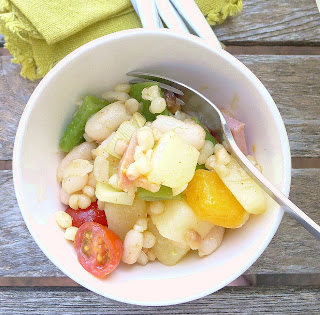 |
| A soup transmogrified to a summer salad! White beans, pasta, fennel and smoked ham make a salad bowl fit for a party on the terrace. |
I´ve just replenished the pantry with jars of legumes, having used the last of them last week with a tasty garbanzo salad. While I’m on to a good thing, why not keep it going?
The “good thing” being salads or cold dishes based around legumes and lots of vegetables. This week I took inspiration from soup! Spain has so many terrific soups and soupy-stews, one-pot meals packed with flavor, nutrients and, yep, calories. Not the sort of food you want to cook—or eat—on a hot summer’s day.
But swap out ready-to-eat canned beans for the slow-cooked dried ones. Substitute raw vegetables for some of the stewed ones. And, in about 30 minutes, you’ve got a hot-weather meal or a side dish fit for a party.
The soup I picked to flip to summer guise is a potaje from Almería and the highland Alpujarra region of Granada. It’s usually cooked with wheat berries, beans or chickpeas, and wild fennel shoots as well as pork belly, ham and sausage. The fennel adds a subtle sweet anisette flavor that translates nicely to a salad when made with raw cultivated fennel.
Smoked ham or turkey from the deli takes the place of the fatty porky bits. For a vegetarian version, just skip the ham. (Smoked tofu would be a nice addition here.)
No fennel? Use chopped celery for a similar crunch and add a herb such as fresh oregano or mint to take up the flavor slack. You could use diced carrots in place of the butternut squash; green pepper instead of green beans.
Instead of chewy wheat berries, which take forever to cook, I’ve used a toasty, round semolina pasta called fregola. Other quick substitutes for the wheat berries are brown or white rice, Israeli cous cous, orzo pasta or bulgur.
Any type of canned white beans can be used or black-eyed peas or chickpeas.
The vegetables improve with a few hours to macerate in the dressing.
 |
| This big salad is packed with vegetables, raw and cooked. Serve it alongside grilled foods at your next party. |
 |
| Sprigs of green fennel and a dusting of smoked pimentón are the final touch to the salad. |
Salad with Fennel and Beans
Ensalada con Hinojo y Alubias
Serves 8-10 as part of a meal.
 |
| Chopped fennel. |
1 cup uncooked fregola or other pasta or grain
1 ½ cups (8 ounces) diced potato
1 cup diced butternut squash
1 cup sliced green beans
1 cup diced smoked ham (6 ounces)
1 cup chopped raw fennel
½ cup finely chopped onion
1 cup cherry tomatoes, halved
2 cloves garlic, minced
½ teaspoon smoked pimentón (paprika)
1/8 teaspoon cumin
1 ½ teaspoons salt
3 tablespoons Sherry vinegar
6 tablespoons extra virgin olive oil
Pinch hot pimentón or dash of Tabasco
Sprigs of fennel to garnish
Cook the fregola in boiling salted water until al dente, 10-12 minutes. (One cup raw pasta makes 2 cups cooked.)
Cook the diced potato in boiling salted water until just tender. Drain and rinse in cold water. Cook the squash in boiling salted water until firm-tender, 5-6 minutes. Cook the beans until crisp-tender. Drain and cool the vegetables and add them to the bowl with the white beans. Add the diced ham, fennel, onion and tomatoes.
 |
| Mix gently so beans don't break up. |
In a small bowl, combine the garlic, pimentón, cumin and salt. Stir in the vinegar. Whisk in the olive oil until dressing is emulsified. Season to taste with hot pimentón or a dash of Tabasco. Pour the dressing over the vegetables in the bowl. Use a large wooden spoon to very gently combine. Taste the vegetables and add more salt, oil or vinegar if needed.
Allow the salad to macerate at least 30 minutes or, covered and refrigerated, up to 12 hours. Stir it again gently before serving. Sprinkle the top with additional pimentón. Garnish with green fennel sprigs.
The first day of summer marked the end of the "state of emergency." All of Spain has now transitioned from pandemic lockdown to what is designated "the new normal." The first tourists have arrived in Mallorca! Shops, bars and restaurants are reopening. We wear masks while on the street, in the market, in offices and other places of work. We can even have a party in our homes and get together with friends! I'm not actually having a party--but this salad would certainly serve a crowd!
More recipes with fennel:
Fennel Soup with Chickpeas, Wheat and Sausage.
Lenten Fennel Soup with Beans.
Bean Pot with Fennel and Pork Belly.
Orange, Avocado and Fennel Salad.
Pear and Fennel Salad with Walnuts.






































